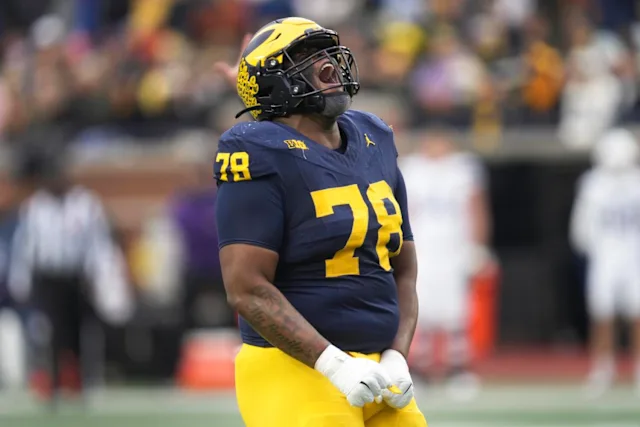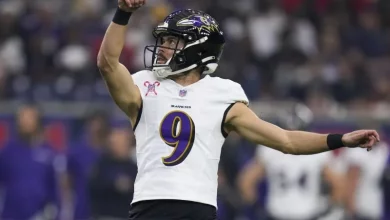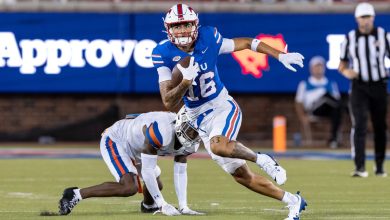Dalton Brooks of Texas A&M football was ejected for targeting during the first-week match against Notre Dame.

Texas A&M Football’s Dalton Brooks Ejected for Targeting vs. Notre Dame in Week 1 Game: Analyzing the Controversial Call and Its Impact on the Aggies
The opening game of the 2025 college football season for Texas A&M was supposed to be a showcase of the team’s potential, but it turned into a moment of controversy and frustration. As the Aggies took on Notre Dame in what was billed as a marquee Week 1 matchup, the game’s narrative took an unexpected turn when Texas A&M’s Dalton Brooks was ejected for targeting. The incident not only shifted the momentum of the game but also sparked debates across the college football world about the fairness of the targeting rule and its application.
Dalton Brooks, a sophomore linebacker for Texas A&M, was one of the standout players for the Aggies going into the season. Known for his hard-hitting style and aggressive approach to defense, Brooks was expected to play a key role in Texas A&M’s defense, especially in a high-stakes game against a perennial powerhouse like Notre Dame. However, after a hard tackle in the second quarter, Brooks was flagged for targeting, a penalty that resulted in an automatic ejection from the game.
This decision was met with a mixture of confusion, anger, and frustration from both the Texas A&M sidelines and its fan base. Fans, analysts, and even former players were left questioning the application of the targeting rule, especially in a case where the hit in question didn’t appear to meet the spirit of the rule. Was Brooks unfairly penalized, or was the call justified? And more importantly, what impact did this ejection have on the Aggies as they tried to hold their ground against Notre Dame?
The Targeting Call: What Happened?
The incident that led to Dalton Brooks’ ejection came in the second quarter of the game. The Aggies were locked in a tense battle with the Notre Dame Fighting Irish, with both teams trading blows and momentum. On a crucial defensive play, Brooks stepped up to deliver a tackle on Notre Dame’s running back as he made a break for the first down.
At first glance, the hit appeared to be textbook: Brooks squared up, lowered his shoulder, and made contact with the ball carrier. However, the referees threw a flag for targeting, citing that Brooks had made contact with the crown of his helmet and led with his head. The officials invoked the targeting rule, which resulted in an automatic ejection for Brooks.
The targeting rule, introduced in college football to protect players from head and neck injuries, stipulates that a player can be penalized for making forcible contact with an opponent’s head or neck area, particularly if the defender leads with the crown of the helmet. The penalty is severe: a 15-yard penalty and an automatic ejection, regardless of intent or whether the hit was deemed malicious.
In this case, many observers believed that Brooks’ tackle didn’t fall into the typical “targeting” category. The hit appeared to be a clean form tackle, with Brooks using his shoulder rather than his helmet as the primary point of contact. Despite this, the officials upheld the call, leaving many onlookers scratching their heads as to whether the rule had been applied correctly.
The Reaction: A Divisive Call
The ejection of Dalton Brooks quickly became the focal point of discussion in the aftermath of the game. Texas A&M head coach Jimbo Fisher was visibly upset on the sidelines, questioning the fairness of the call and the application of the targeting rule. “I don’t think it was targeting,” Fisher said in his post-game interview. “Dalton made a clean, hard hit, and it’s tough to see him get thrown out for something like that. I’m frustrated because that’s not the way the game is supposed to be played.”
Fisher’s sentiments were echoed by Texas A&M fans, many of whom took to social media to voice their frustration. While they recognized the need for player safety and the importance of protecting athletes from head injuries, many felt that the rule was being applied too rigidly, penalizing clean tackles that happen to involve some incidental contact with the helmet. “Football is a physical game,” one fan tweeted. “That was a hard hit, but it wasn’t targeting. We’re taking the physicality out of the game.”
Former players, analysts, and coaches also weighed in on the controversy, with some agreeing that Brooks had been unfairly penalized. “It looked to me like Brooks was just trying to make a solid football play,” said former NFL player and analyst Charles Woodson. “I understand the targeting rule is in place for safety, but it can’t be over-applied. That wasn’t a dirty hit.” Others, however, argued that the referees had to err on the side of caution in these situations, as player safety is paramount.
On the other side of the debate, Notre Dame fans were quick to defend the call, arguing that it was justified. They pointed to the fact that Brooks had made contact with the crown of his helmet, even if it was unintentional, and that this type of hit is precisely what the targeting rule aims to prevent. “The rule is there for a reason,” one Notre Dame fan posted. “We’ve seen too many players suffer from head injuries. It may have been a tough call, but the safety of the players has to come first.”
The Impact on the Aggies
As the ejection of Dalton Brooks reverberated through the game, its impact on the Texas A&M defense became immediately evident. Brooks was one of the most important players on the Aggies’ defense, known for his sideline-to-sideline range and his ability to deliver big hits. His absence left a significant void, one that the Aggies struggled to fill for the remainder of the game.
Notre Dame, buoyed by the loss of Brooks, began to capitalize on the Aggies’ defensive lapses. The Fighting Irish scored quickly after Brooks’ ejection, taking advantage of a defense that was forced to adjust without one of its top playmakers. Brooks had been a key component of Texas A&M’s defense, and without him, the Aggies struggled to contain Notre Dame’s offense, especially in the running game.
While Texas A&M did its best to rally, the loss of Brooks was a significant blow to their chances. Notre Dame, despite not having the most explosive offensive attack, was able to methodically move the ball down the field and capitalize on some of the defensive breakdowns that occurred in the wake of Brooks’ ejection.
On a broader level, the ejection of Brooks highlighted a larger issue for Texas A&M: depth. While the Aggies have talented players on defense, the team’s ability to recover from losing a key player like Brooks showed the importance of having strong depth at every position. Losing Brooks, even for a short period of time, left a noticeable gap in the defensive lineup. The lack of experienced backups to fill his role also underscored a potential area for improvement for the Aggies moving forward.
The Targeting Rule: A Growing Debate
Dalton Brooks’ ejection reignited the ongoing debate about the targeting rule in college football. On one hand, the rule was introduced with the intention of protecting players from potentially career-ending injuries, especially in a game that’s known for its violent collisions. The increasing awareness of concussions and head trauma has made player safety a top priority for governing bodies like the NCAA.
However, many critics argue that the rule has become overly punitive, penalizing players for hits that aren’t necessarily dangerous or malicious. In the case of Brooks, many felt that the ejection was too harsh given the circumstances. The rule, they argue, is often applied in situations where the intent wasn’t malicious, and the physicality of football should allow for hard tackles without fearing automatic ejection.
The inconsistency in how targeting is called—sometimes it’s enforced, sometimes it’s not—has added to the confusion and frustration. In some cases, the targeting penalty is rescinded after review, but in many instances, a player is automatically ejected without the opportunity for further review. This inconsistency in enforcement has led to calls for reform.
Some have suggested changes to the rule itself, such as allowing for a more nuanced application of the penalty or giving officials the discretion to assess whether the hit was truly dangerous. Others advocate for the creation of a two-tiered penalty system, where a player could receive a 15-yard penalty without being ejected, with ejections reserved for only the most egregious examples of targeting.
What’s Next for Texas A&M?
Following the ejection, Texas A&M had to regroup and move forward without Dalton Brooks for the remainder of the game against Notre Dame. While the Aggies fought hard, the loss of their key defensive player ultimately led to a 34-27 defeat. The game was a hard-fought battle, but Texas A&M’s defense was unable to recover from Brooks’ absence.
Looking ahead, the Aggies will need to make adjustments and ensure that their defense is not overly reliant on one player. While Brooks is an excellent talent, the team cannot afford to let one injury or ejection derail its entire season. Coach Jimbo Fisher will have to focus on building depth and ensuring that his team is equipped to handle any future adversity, including any more targeting calls that could potentially impact the roster.
As for Dalton Brooks, he will have to put the ejection behind him and focus on staying healthy and continuing to develop as one of the team’s defensive leaders. The Aggies will need his leadership throughout the season, and his ability to avoid any further suspensions or injuries will be crucial to the team’s success moving forward.









